From The CRPG Addict
 |
| This screen is the same in both the German and English versions. |
Zeret (developer); published by CompuTec Verlag (German) and Amiga Mania (English)
Released in 1992 for the Amiga
Date Started: 7 January 2020
 |
| The German version supplies the backstory. |
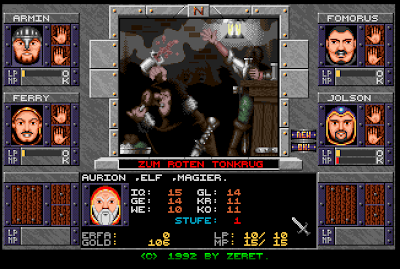 |
| Creating a new character. |
- Armin, a human knight
- Fomorus, a troll fighter
- Ferry, a half-elf thief
- Jolson, a dwarf monk
- Aurion, an elf magician
- Taliesin, a lizzard wizard
 |
| The shopowner is proud of his limited wares. |
I couldn’t find any English version in which that problem had been repaired, so I switched to a “patched” German version (although I don’t know if that’s one of the things it patched), which meant starting over with new characters and losing a couple of hours of progress. Fortunately, the game is not that text-heavy, and I can read a lot of it without needing a translator, thanks to previous German RPG experience. Also, a lot of the text is in English even in the German version, including the title.
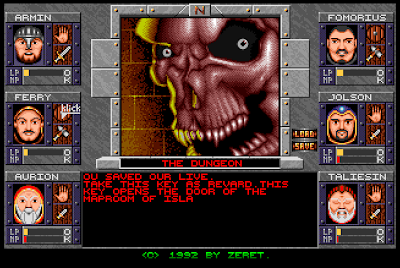 |
| Not only is this encounter in the wrong place, he doesn’t actually give you a key. |
There are 10 levels of 32 x 32 to explore (with worm-tunnel walls), divided into two structures: the dungeon and the Tower of Roa. (The first game had 50 x 50 levels, but fewer of them.) A menu town with a shop, a temple, and a training guild sits outside.
Exploration is not entirely “open,” but it’s less linear than the typical dungeon crawler. Each level has multiple sections, some disconnected from the others, and at any given moment you’re probably looking for at least three keys, objects, puzzle solutions, or other necessities to uncover different areas.
 |
| You have to check all walls for these little floor buttons. Pressing them removes the wall. |
The levels also wrap, which always disappoints me. Wrapping dungeon levels give you a momentary navigation pause, but they otherwise offer little extra challenge to justify tearing the player out of any sensible reality.
 |
| My map of Level 2 of the main dungeon. Note the north/south wrap on column 6. |
The levels are full of the types of light puzzles I remember from the first game. Small grates at the bottom threshold of the walls indicate secret doors; sometimes you have a dozen of these in a sequence. Other secret doors are revealed by pressure plates or wall switches. There are teleporters, traps, spinners, magic barriers, and occasional “ice floors” that send you careening down long hallways with no ability to stop. Fortunately, a group of spells keep you oriented and solve most of the navigation issues, including “Vogelblick” (“Birds’ View”) “Magier Auge” (“Magic Eye”), and “Falkenfeder” (“Levitation”).
 |
| The game’s automap is quite good, though not enough that I could rely on it exclusively. |
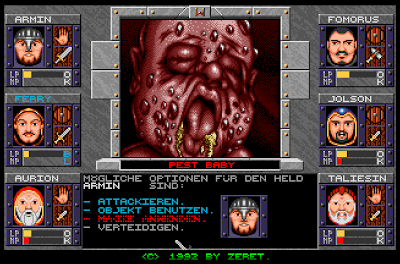 |
| Combat options when attacking a “pest baby” include attacking, using an object, casting a spell, and defend. |
The game strikes a good balance in difficulty. It allows you to save anywhere, but you can only camp (to recover health and magic points) on rare fixed squares that have an emblem with the letter “C.” You have to keep spell points in reserve to handle the occasional blindness, poison, disease, or petrification.
 |
| Final statistics after a battle with an “invisible.” |
There’s been some nice ambient sound–creaks and groans and moaning wind as you explore the dungeon corridors. Unfortunately, it’s a bit repetitive and can’t be turned off independently from the music, which is well composed but (as always with me) unwelcome. Thus, I have been playing mostly in silence.
Perhaps the best part of the game is the grotesque monster portraits and other unusual graphics. The graphics are credited jointly to Hakan Akbiyik, Frank Matzke, and Klaus Ehrhardt. I’ve checked out their individual portfolios and don’t see anything quite the same as the Avalon games, so I’m not sure who to credit.
 |
| The authors’ conception of a “zombie.” |
 |
| This dragon wants a “dragon stone.” |
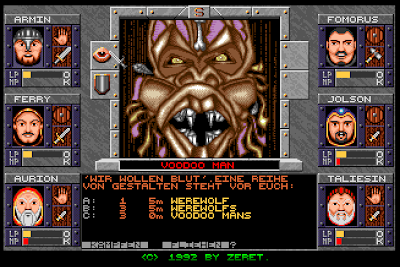 |
| This “voodoo man” might be considered a little “questionable” today. |
Unfortunately, the game has a lot of negative points, too:
1. I don’t care for the controls much. Too much depends on the mouse. You can move with the arrow keys but not activate doors or switches. Number keys open the characteristics of the characters, but you then have to use the mouse to switch to inventories or exit. When you’re given numbered commands on the screen, you can’t activate them with the number keys–you have to click on them. Things like that add up.
2. As with its predecessor, characters in Dungeons of Avalon II start hitting their level caps with two or three game levels left to go.
3. There might as well have been no economy. After you equip your characters at the beginning, the only thing to spend money on is the occasional temple healing and leveling up. For your first 4 or 5 character levels, you’re chronically under-funded and almost always waiting for enough gold to advance half your party. Pretty soon, the situation reverses and you have tens of thousands of gold pieces.
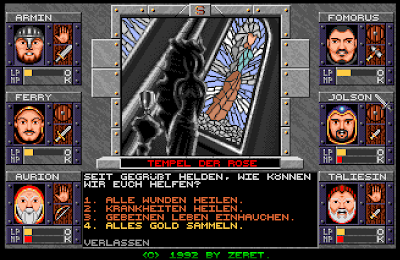 |
| If you don’t get diseased or killed much, money doesn’t have a purpose. |
4. It’s too goddamned long, particularly where the encounters leave you no reason to fight once you’ve hit the level cap except that all the encounters are fixed. A diskmag dungeon crawler of this skill would have been perfect at 12-16 hours. Instead, I think it’s going to come very near to 40.
As the game begins, you can enter either the dungeon on Level 0 or the Tower of Roa on Level 5. But the part of the Tower that you enter takes you only a short distance before you run into either locked doors or an encounter with a giant named “Argha” who wants you to bring him a dragon to grant passage.
You thus have to explore a while in the main dungeon. The game follows European hotel tradition by designating the first floor “0” and the second floor “1.” Level 0 is full of long, snaky corridors with a lot of false walls that have to be opened with switches. In the far southern corridor is a teleporter that takes you to a central area with four pressure plates (and four camping squares), the combinations of which determine which corridors are open at which times. The pressure plate is preceded by message squares that say “BEAM ME UP SCOTTY” in the German version but misspell “BEAM” as “BAEM” in the English version.
The northern half of the level is suggested as a “jail” with numerous cells curving off the main corridor, most hosting fixed combats. A guardian blocks the way to this area until you give him a letter of invitation, which is found in a treasure chest to the southeast.
Monsters on Level 0 are mostly giant turtles and giant frogs, neither of which has any special attacks. They ease you nicely into the combat system.
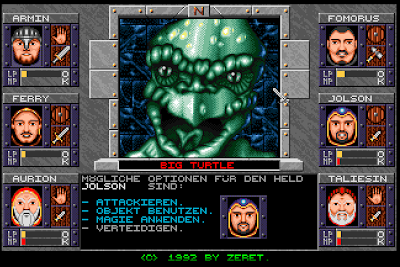 |
| A freaky-looking turtle. |
Two of the “cells” have special encounters. A dragon is looking for a “dragon stone” for some reason. A group of thieves offers to trade a key for their freedom, although I neglected to write down what I had to do to achieve their freedom. Their key ends up opening the “map rooms” in the Tower of Roa, allowing some further progression on its first level.
 |
| Some thieves complain about being locked up. |
A teleporter brings the party to a long north/south corridor that leads to the stairs to Level 1. There, things get more complicated. A small, winding corridor leads you immediately to the stairs to Level 2, which you must nearly fully explore before you find stairs back up to Level 1.
The main part of Level 1 is presented as a rectangular hallway with six crypts jutting to the east and west. The crypts belong to royalty of ages past–kings and queens and princes of Avalon, Isodor, and the Isle Rachon. A couple of them are answers to later puzzles that otherwise block progress. One of the kings is given as the king of “ZD and CT,” which is I assume a reference to Zeret and CompuTec.
 |
| Zouth Dakota and Connecticut? |
In a chest deep in the level, you find the first truly good equipment. Until then, you’ve mostly been stuck with the stuff you bought at the beginning, plus perhaps a few scrolls, potions, and regular missile weapons for the rear characters. Here, you find Arc’s Helmet and Ara’s Armour, Arc and Ara being heroes of ages gone. Mysteriously, you also find a few treasure chests that go into your inventory as whole chests. I’ve tried everything, and I don’t think there’s any way to open them. I think maybe you’re just expected to sell them whole.
 |
| What am I supposed to do with these damned chests? |
I’ll stop there so I have something to talk about next time. I poured hours into this game over the weekend, hoping to finish it for a single entry, but it was to no avail. Cross your fingers and hope I can win this one.
Time so far: 24 hours
Original URL: http://crpgaddict.blogspot.com/2020/01/game-352-dungeons-of-avalon-ii-island.html
